Lakhmir Singh & Manjit Kaur: Sources of Energy, Solutions- 3 | Lakhmir Singh & Manjit Kaur Solutions: Class 10 Science PDF Download
Page No:141
Question 16: Compare the sun and the fossil fuels as the sources of energy.
Solution : Sun is a renewable source of energy, where as fossil fuels are non-renewable sources of energy.
Question 17: What kind of mirror, concave, convex or plane, would be best suited for use in a solar cooker ? Why ?
Solution : Concave and plane mirrors are used for making solar cooker because concave mirror converges a large amount of sun’s rays at a point that is required for high heating and plane mirror reflects the rays of light in the form of a strong beam of sunlight on the top of the box that is required for moderate heating.
Question 18: (a) Name that part of a box-type solar cooker which allows the sun’s heat rays to enter the box but does not
allow inside heat to go out.
(b) Explain why, a plane mirror reflector is used in a box-type solar cooker.
Solution : (a) Glass sheet cover
(b) A plane mirror reflector is used in a box type solar cooker so as to get a strong beam of sunlight after reflection from the mirror.
Question 19: What are the advantages and disadvantages of using a solar cooker ?
Solution : (a) Advantages of using solar cooker
(i) It saves precious fules like coal, kerosene etc.
(ii) It does not produce any smoke or ash.
(iii) The food cooked in a solar cooker has all its nutrients intact.
(b) Disadvantages of using solar cooker
(i) Solar cooker cannot be used during night time.
(ii) If the day-sky is covered with clouds, it will not be possible to cook the food using solar cooker.
(iii) Direction of reflector has to be changed from time to time to keep it facing the sun.
Question 20: (a) What is a solar cell ? Draw the labelled diagram of a solar cell.
(b) Name the semi-conductor material which is usually used for making solar cells.
(c) Write the uses of solar cells.
Solution : (a) Solar cell is a device which converts solar energy directly into electrical energy.
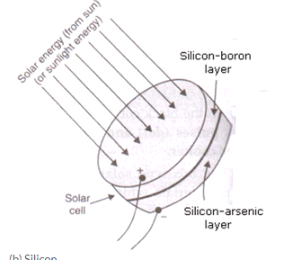
(b) Silicon
(c) Use of solar cell:
i. To provide electricity in artificial satellites and space probes.
ii. To provide electricity to remote areas where normal electricity transmission lines do not exist.
iii. To provide electricity to light houses
iv. To operate traffic signals, watches, calculators and toys.
Question 21: State the advantages and disadvantages of using solar cells.
Solution : (a) Advantage of solar cell
(i) They have no moving parts and require no maintenance.
(ii) They can be set up in remote and inaccessible areas
(b) Disadvantage of solar cell
(i) They are very expensive.
(ii) They are less efficient. They can convert only about 25 % of light falling on them into electricity.
(iii) They cannot work during night time.
Question 22: What is a solar cell panel ? For what purpose is it used ? State its two main advantages.
Solution : Solar cell panel consists of a large number of solar cells joined together in a definite pattern. It is used to convert solar energy into electricity.
Advantages of solar cell panel are:-
1. It provides much more electric power than a single solar cell.
2. It is used to provide electricity in remote and inaccessible rural areas.
Question 23: (a) What is solar constant ? What is the value of solar constant ?
(b) If the energy received by 5 m2 area in 10 minutes is 4200 kj, calculate the value of solar constant.
Solution : (a) The amount of solar energy received per second by one metre square area of the near earth space (exposed perpendicularly to the sun rays) at an average distance between the sun and the earth, is known as solar constant. Its value is 1.4 kJ/s/m2.
(b) Area, A=5m2; time,t=10 min=600sec; E=4200 kJ.
Solar constant =E/(Axt)
=4200/(5×600)
=1.4 kJ/s/m2
Question 24: How has the traditional use of energy of flowing water been modified for our convenience ?
Solution : Traditionally, the energy of flowing water has been used for rotating the water-wheels and for driving water-mills to grind wheat to make flour. The traditional use of energy of flowing water has been modified by improvements in technology and it is now used to generate electricity.
Question 25: How has the traditional use of wind energy been modified for our convenience ?
Solution : Traditionally, wind energy was used through windmills to pump water from a well and to grind wheat into flour. But the traditional use has been modified and now it is used for the generation of electricity.
Question 26: (a) What is hydroelectricity ? Explain the basic principle of generation of hydroelectricity with the help of a
labelled diagram.
(b) State two advantages of producing hydroelectricity.
(c) State two disadvantages of producing hydroelectricity.
Solution : (a) The electricity generated from hydro power plant is known as hydro electricity.
Water is collected in a reservoir at a height, so the water has potential energy stored in it. When the water flows down through this large height, its potential energy gets converted into kinetic energy. The fast flowing water rotates the turbine which is connected to generator through its shaft. The generator produces electricity.

(b) Advantage of producing hydroelectricity:
(i) It does not cause any environmental pollution.
(ii) It uses the energy of flowing water, which is a renewable source of energy
(c) Disadvantage of producing hydroelectricity
(i) Large areas of land are required.
(ii) Large eco-systems get destroyed.
Question 27: (a) With the help of a labelled diagram, explain the construction and working of a solar cooker.
(b) Why is the solar cooker box painted black from inside ?
(c) Why is the solar cooker box covered with a glass sheet ?
Solution : (a) Construction and working of solar cooker
A solar cooker consists of an insulated metal box or wooden box which is painted all black from inside. There is a thick glass sheet cover over the box and a plane mirror reflector is also attached to the box.
The food to be cooked is put in metal containers which are painted black from outside. These metal containers are then placed inside the solar cooker box covered with the glass
sheet. The sun’s rays fall on the reflector, get reflected into the box through the upper glass and get trapped within it.
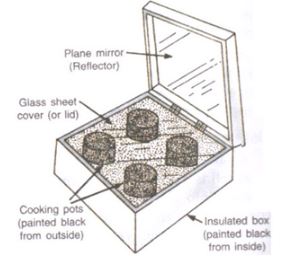
(b) Solar cooker inner body is painted black because black color is a good absorber of heat, so it traps the maximum rays from the sun.
(c) Solar cooker is covered with a glass sheet so as to trap the heat rays in the interior of the box of the cooker.
Question 28: (a) What is wind ? What type of energy is possessed by wind ?
(b) Explain how, wind energy can be used to generate electricity. Illustrate your answer with the help of a labelled diagram.
(c) State two advantages of using wind energy for generating electricity.
(d) Mention two limitations of wind energy for generating electricity
Solution : (a) Moving air is known as wind. Wind posses kinetic energy.
(b) The fast moving wind strikes the wind turbine which starts rotating. The shaft of the wind turbine also rotates and drives the generator which produces electricity.
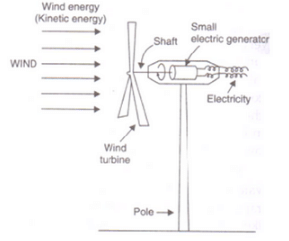
(c) Advantages of using wind energy for generating electricity:
(i) It does not cause any pollution.
(ii) It is available free of cost.
(d) Limitations of wind energy:
(i) Wind energy farms cannot be established everywhere. They can be established only at those places where wind blows for most part of the year.
(ii) Wind energy farms require large area of land for their establishment.
Page No:142
Question 39: A large coal-fired power station produces 2000 MW of electrical energy. A wind turbine with 33 m blades can produce 300 kW.
(a) How many turbines would be needed to replace the power station ?
(b) Why, in actual practice, this number of turbines could not replace the coal-fired power station ?
Solution : (a) Electrical energy produced by coal-fired plant = 2000MW = 2000x106W
Electrical energy produced by wind turbine = 300kW = 300x103W
No. of wind turbine required = 2000×106/300×103 = 6666.6
So, 6667 wind turbines would be needed to replace the power station.
(b) In actual practice, this no. of wind turbines could not replace the coal-fired power plant because the efficiency of wind turbines keeps changing due to changes in wind speed but the efficiency of steam turbines used in coal-fired power stations remains the same.
Question 40: In a solar water heater, why is the storage tank placed at a higher level than the solar panel containing coils ?
Solution : This is because hot water, being lighter and less denser, rises to the top.
Question 41: In many applications, solar cells are connected to rechargeable batteries. Why is this so ?
Solution : The electricity made by the solar cells during day time is stored in rechargeable batteries so that it can be used later on, for example, at night.
Question 42: (a) Solar cells are used to provide the electric current to charge the batteries of a car driven by an electric
motor. Describe the energy changes which take place.
(b) What differences would you expect in the charging of car batteries (i) in bright sunlight (ii) on a cloudy day (iii) at night ?
Solution : (a) Solar cells convert solar energy into electrical energy.
While charging the batteries, electrical energy is converted into chemical energy.
During the use of batteries, chemical energy is converted into electrical energy; then electric motor converts electrical energy into kinetic energy (which drives the car).
(b) (i) Batteries are charged quickly.
(ii) Batteries are charged very slowly.
(iii) Batteries are not charged at all.
Page No:148
Question 1: What substance is obtained as a residue when wood is burned in a limited supply of air ?
Solution : Charcoal.
Question 2: Name one source of energy which is not derived from solar energy directly or indirectly.
Solution : Geothermal energy.
Question 3: What name is given to the heat energy obtained from hot rocks inside the earth ?
Solution : Geothermal energy.
Question 4: Name the agent which decomposes animal dung into biogas.
Solution : Anaerobic bacteria.
Question 5: Which component of biogas is used as a fuel ?
Solution : Methane.
Question 6: Name the constitutents of biogas.
Solution : Bio gas consists of methane, carbon dioxide, hydrogen and hydrogen sulphide.
Question 7: Which of the following is needed for the formation of biogas from cow-dung and which not ?
Water, Oxygen
Solution : Needed:- water.
Not needed:- oxygen.
Question 8: Name the clean fuel which can be obtained from cow-dung.
Solution : Biogas.
Question 9: Apart from cattle dung, what other substances can be added to a biogas plant ?
Solution : Apart from cattle dung, human excreta, agriculture wastes, vegetable wastes, poultry droppings, paper scrap etc. can also be added to a biogas plant.
Question 10: Name any three forms of energy which could be harnessed from the sea.
Solution : Three forms of energy which could be harnessed from the sea are:
(i) Tidal energy
(ii) Wave energy
(iii) Ocean thermal energy.
Question 11: Write two forms in which solar energy manifests itself in sea.
Solution : (i) Sea-waves energy.
(ii) Ocean thermal energy.
Question 12: Write the full form of OTE.
Solution : OTE stands for Ocean Thermal Energy.
Question 13: What is the function of anaerobic micro-organisms such as anaerobic bacteria in a biogas plant ?
Solution : Anaerobic bacteria help in the degradation of cow-dung in the presence of water but in the absence of oxygen.
Question 14: State whether the following statement is true or false :
Tidal energy is one of the forms in which solar energy manifests itself in oceans.
Solution : False
Question 15: Fill in the following blanks with suitable words :
(a) Biomass is another form in which……… energy manifests itself.
(b) Tidal waves build up and recede……….. a day.
Solution : (a) solar. (b) twice.
Question 16: (a) What is biomass ? Give three examples of biomass.
(b) Name the biomass which is still widely used as a source of heat energy in many households of our country.
Solution : (a) The dead parts of plants and trees, and the waste material of animals are called biomass. It is the organic matter which is used as a fuel to produce energy. E.g., wood, agricultural wastes and cow dung.
(b) Wood.
Question 17: What are the two ways in which cow-dung can be used as a fuel ? Which of them is better and why ?
Solution : Two ways in which cow-dung can be used as a fuel are:
1. In the form of cow-dung cakes, which can be used directly as a fuel.
2. By preparing biogas from cow-dung.
Biogas is better than cow-dung cakes because it gives a cleaner than cow-dung cakes and after extracting biogas, the spent cow-dung can be used as a manure.
Page No:149
Question 18: How is charcoal prepared ? Explain why, charcoal is a better fuel than wood.
Solution : Charcoal is prepared by burning wood in a limited supply of air, so that water and other volatile materials present in it get removed.
Charcoal is a better fuel than wood because it has a higher calorific value than wood, and it burns without producing smoke wheras wood produces a lot of smoke on burning.
Question 19: Compare and contrast biomass and hydroelectricity as sources of energy.
Solution : (i) Biomass is a renewable source of energy and hydroelectricity is also a renewable source of energy.
(ii) The use of biomass by burning causes air pollution but the use of hydroelectricity does not cause any pollution.
(iii) Biomass gives heat energy which can be used for cooking and heating only. On the other hand, hydroelectricity can run all types of electricical appliances.
(iv) Biomass energy can be obtained without using any special device but hydroelectricity can be produced only by establishing hydro-power plants.
Question 20: Why is biogas considered an ideal fuel for domestic use ?
Solution : Biogas is considered an ideal fuel for domestic use because:
(a) Biogas burns without smoke and hence does not cause air pollution.
(b) Biogas has a high calorific value. That is, biogas produces a large amount of heat per unit mass.
(c) Biogas is cheaper than most common fuels.
(d) Biogas is a clean fuel since it burns completely without leaving any residue behind.
Question 21: (a) Explain how tidal energy can be used to generate electricity.
(b) Why is tidal energy not likely to be a potential source of energy ?
Solution :
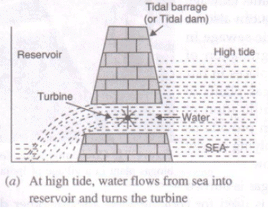
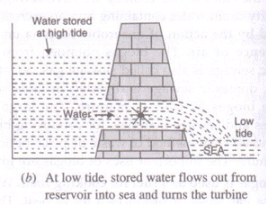
During high tide, when the level of water in the sea is high, sea-water flows into the reservoir of the barrage and turns the turbines. The turbines then turn the generator to produce the electricity. And during the low tide, when the level of sea-water is low, the sea-water stored in the barrage reservoir is allowed to flow out into the sea. This flowing water also turns the turbines and generates electricity.
(b) Tidal energy is not likely to be a potential source of energy because there are very few sites around the world which are suitable for building tidal barrages, and the rise and fall of sea-water during high and low tides is not enough to generate electricity on a large scale.
Question 22: State two ways in which the energy of sea-waves can be harnessed.
Solution : Sea-waves energy can be harnessed by by the following ways:
1. By setting up floating generators in the sea which would move up and down with the sea-waves and their movement would drive the generators to produce electricity.
2. By letting the sea-waves move up and down inside large tubes so that when the waves move up, the air in the tubes is compressed and this compressed air can then be used to turn a turbine of a generator to produce electricity.
Question 23: What is meant by ocean thermal energy ? Explain how ocean thermal energy can be used to generate electricity.
Solution : The energy available due to the difference in the temperature of water at the upper surface and the deeper layers of ocean is known as ocean thermal energy.
Ocean thermal energy is used to generate electricity in an Ocean Thermal Energy Conversion power plant (OTEC power plant). A temperature difference of 20oC or more between the surface water and deeper water is needed for the operation of these plants. The warm surface water of ocean is used to boil a liquid like ammonia or chlorofluorocarbon. The high pressure of liquid vapours is used to turn the turbine of a generator and produce electricity.
Question 24: What are the limitations of energy that can be harnessed from the sea ?
Solution : Limitations of energy that can be harnessed from the sea:
1. There are very few sites around the world which are suitable for building tidal barrage for harnessing tidal energy. Moreover, the rise and fall of sea-water during high and low tides is not enough to generate electricity on a large scale.
2. The harnessing of sea-waves energy is a viable proposition only at those places where sea-waves are very strong.
3. Though the energy potential from the sea is very large but its large scale exploitation is difficult at the moment.
Question 25: Suggest a safe and efficient method for the disposal of biowastes and sewage materials. How is this method advantageous to us ?
Solution : A safe and efficient method for the disposal of biowastes and sewage materials is to utilise them for producing biogas. This method is advantageous to us for getting energy and manure without polluting the environment.
Question 26: Which of the following sources of energy are not derived from the sun ?
Biomass, Wind, Ocean thermal energy, Geothermal energy, Nuclear fuels, Hydroelectricity, Wave energy, Coal, Petroleum, Tidal energy
Solution : Following sources of energy are not derived from the sun:
Geothermal energy, nuclear fuels, tidal energy.
Question 27: (a) What is biogas ? Name the major component of biogas.
(b) What are the raw materials used for making biogas ?
(c) Describe the construction and working of a biogas plant with the help of a labelled diagram.
(d) Write any two uses of biogas.
(e) Write any two advantages of using biogas.
Solution : (a) Biogas is a mixture of gases produced by anaerobic degradation of biomass in the presence of water but in the absence of oxygen. Methane is the major component of biogas.
(b) Cow-dung and water.
(c) Construction and working of biogas plant:
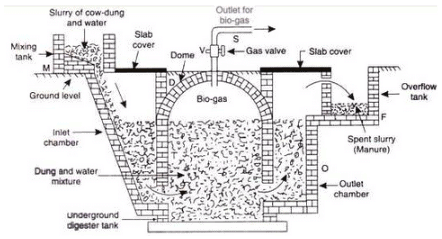
A biogas plant consists of a wall-shaped, underground tank called digester, which is made of bricks, and has a dome shaped roof D. The dome acts as a gas-holder. There is a gas outlet S at the top of the dome having a valve V. There is a sloping inlet chamber I connected to a mixing tank M and a rectangular outlet chamber O connected to the overflow tank F.
Cow dung and water are mixed in equal proportions in the mixing tank M to prepare the slurry. This slurry is fed into the digester tank through the inlet chamber I to fill the tank upto the cylindrical level. Then, the cow-dung undergoes anaerobic degradation with the evolution of biogas which collects in the dome. The pressure of biogas on the slurry forces the spent slurry to go into the overflow tank F through outlet chamber O, from where it is removed.
(d) Two uses of bio gas:
(i) For cooking purpose
(ii) For lightning purpose
(e) Two advantages of biogas:
(i) Smoke-free cooking
(ii) High calorific value
Question 28: (a) What is geothermal energy ?
(b) What is the source of heat contained in geothermal energy ?
(c) Explain how, geothermal energy is used to generate electricity.
(d) State two advantages of geothermal energy.
(e) State two disadvantages of geothermal energy.
Solution : (a) Geothermal energy is the heat energy from hot rocks present inside the earth.
(b) Hot rocks present inside the earth are the source of heat contained in geothermal energy.
(c) Extremely hot rocks present below the surface of earth heat the underground water and turn it into steam. As more and more steam is formed between the rocks, it gets compressed to high pressures. This high pressure steam is brought up through pipes and is used to run the turbine of a generator to produce electricity.
(d) Advantage of geothermal energy:
(i) It is very economical to use.
(ii) It does not cause any pollution.
(e) Disadvantage of geo thermal energy:-
(i) It is not available everywhere.
(ii) Deep drilling in the earth is required, which is technically very difficult and expensive.
Page No:150
Question 42: A certain form of energy is available due to the difference in the temperature of water at the surface of the ocean and its deeper levels.
(a) Name the form of energy.
(b) Is this energy ultimately derived from the sun or not ?
(c) Explain how this form of energy can be converted into electricity.
(d) What is the minimum temperature difference in water at the surface of ocean and its deeper level which is required to operate power plants based on this energy ?
Solution : (a) Ocean thermal energy
(b) No
(c) Ocean thermal energy is used to generate electricity in an Ocean Thermal Energy Conversion power plant (OTEC power plant). A temperature difference of 20oC or more between the surface water and deeper water is needed for the operation of these plants. The warm surface water of ocean is used to boil a liquid like ammonia or chlorofluorocarbon. The high pressure of liquid vapours is used to turn the turbine of a generator and produce electricity.
(d) 200C
Question 43: (a) The gravitational pull of the moon causes the sea-water to rise periodically.
(b) What name is given to the condition of the sea when its water is raised ?
(c) What name is given to the condition of the sea when its raised water recedes ?
(d) What name is given to the energy which can be harnessed from this natural phenomenon ?
(e) Draw labelled diagram to show how this energy can be harnessed to generate electricity.
Solution : (a) High tide
(b) Low tide
(c) Tidal energy
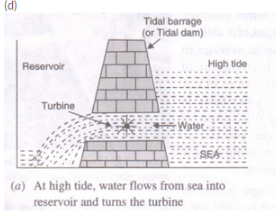
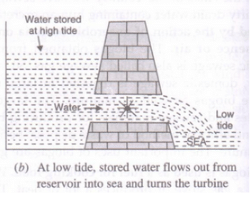
Question 44: When the material A mined from the earth is heated strongly in an insufficeint supply of air, it produces a solid fuel B which consists mainly of carbon. When another material C obtained from trees is heated in an insufficient supply of air, it produces another solid fuel D which also consists mainly of carbon. Name A, B, C and D.
Solution : A is coal; B is coke; C is wood; D is charcoal
Question 45: A certain form of energy which is not sourced directly or indirectly from the sun and does not cause any pollution is very easily converted into electricity. This form of energy is, however, not available everywhere. Moreover, it is technically very difficult and expensive to obtain it. Name the form of energy.
Solution : Geothermal energy.
FAQs on Lakhmir Singh & Manjit Kaur: Sources of Energy, Solutions- 3 - Lakhmir Singh & Manjit Kaur Solutions: Class 10 Science
| 1. What are the different sources of energy discussed in the article? |  |
| 2. How do fossil fuels contribute to the global energy demand? |  |
| 3. What are the advantages of using renewable sources of energy? |  |
| 4. What are the consequences of excessive reliance on fossil fuels for energy production? |  |
| 5. How does nuclear energy differ from other sources of energy discussed in the article? |  |





















